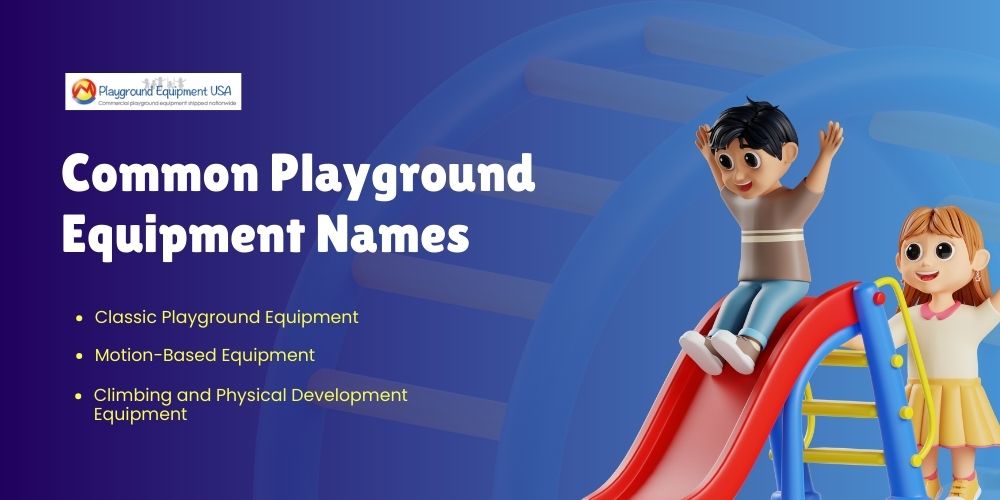
Playgrounds benefit children beyond burning off energy – they provide also locations for children’s learning development, intuitive exploration and creating fond memories!
Playgrounds combine three categories of development – physical movements, social activities, and creative role-playing – at once. Becoming familiar with and understanding playground equipment enables parents, planners, and educators to select appropriate equipment that welcomes inclusivity and allows the children to enjoy themselves!
Classic Playground Equipment Names
1. Merry Go Round Playground
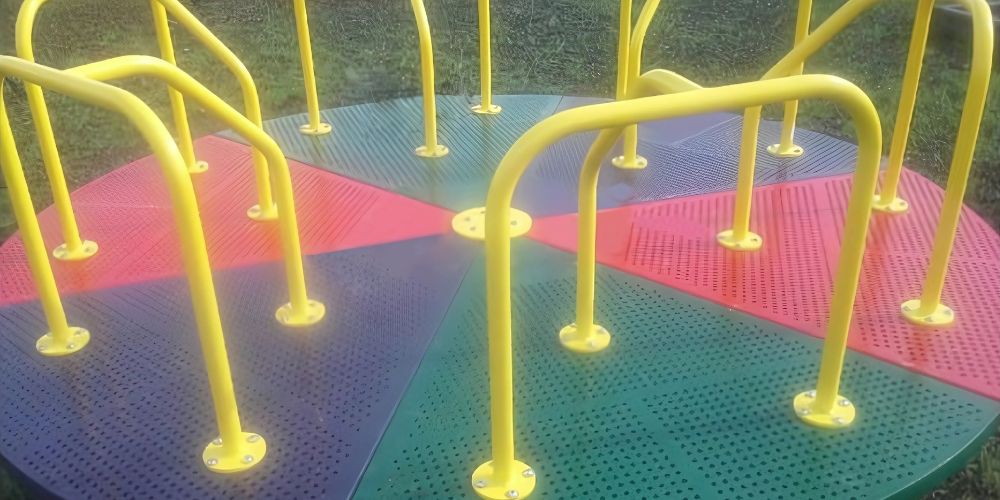

The merry-go-round is one of the few playground components that generates nostalgic feelings. Playground equipment that enabled children to spin was present in every traditional public park. Modern versions feature speed-limiting designs and accessible equipment for children of all capabilities.
2. Seesaw / Teeter-Totter
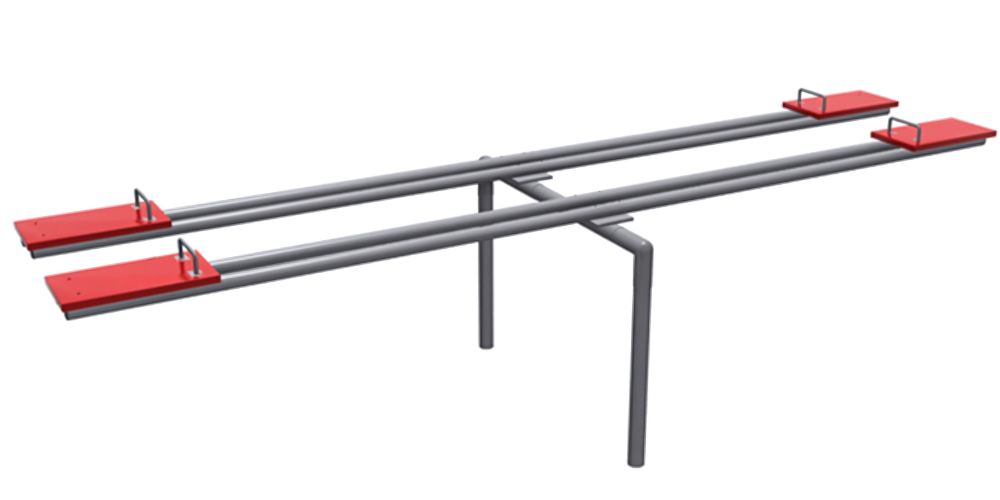

Children enjoy using the traditional playground equipment known as the seesaw. This playground equipment features a long, center-balanced board on which one child’s ascending or descending movement enables their peer to rise. New playground equipment designs integrate safety features, combining springs and cushioned landing mechanisms.
3. Swings
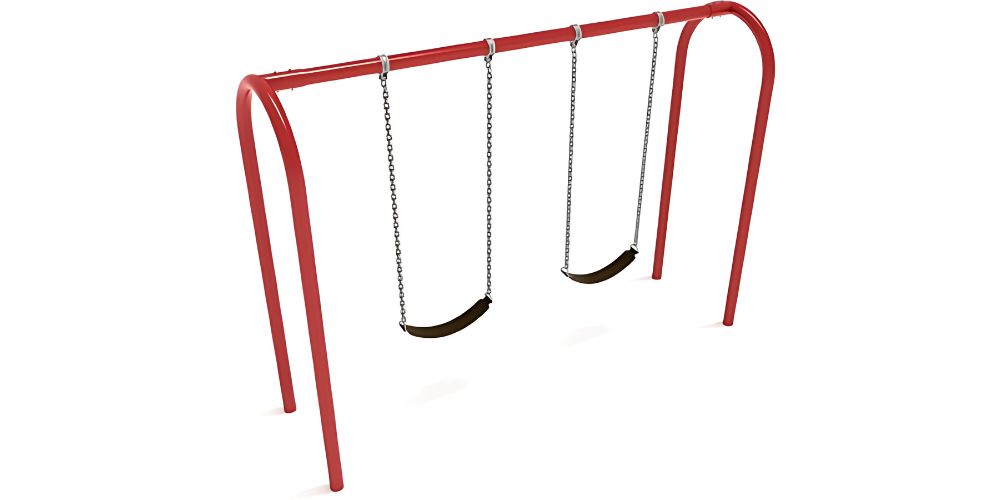
Swings maintain their status as one of the playground attractions that everyone loves to enjoy. Traditional belt swings and high-capacity swing models enable children to enjoy pure joy and develop balance and coordination skills. Two recent seesaw designs, the accelerator swing and the generation swing, welcome users with various capabilities to play together.
Swings function as suspended seats that move through pendulum motion thanks to children leaning back and forth movements.
4. Slides
Slides give the everlasting gift of joy to everyone! Children climb up time after time to experience the excitement of sliding. Today’s available slides feature different heights and shapes and accommodate all ages and safety conditions.

Climbing and Physical Development Equipment Names
Children use climbers as structures to improve their physical skills by ascending grips, nets, or bars. Children experience physical and mental challenges by using climbers. This category includes geodesic domes, vertical nets, rock walls, and log-style obstacles. Playground climbers help users develop their strength, confidence, and coordination, playing an essential role in traditional and recent playground designs.
1. Net Climbers
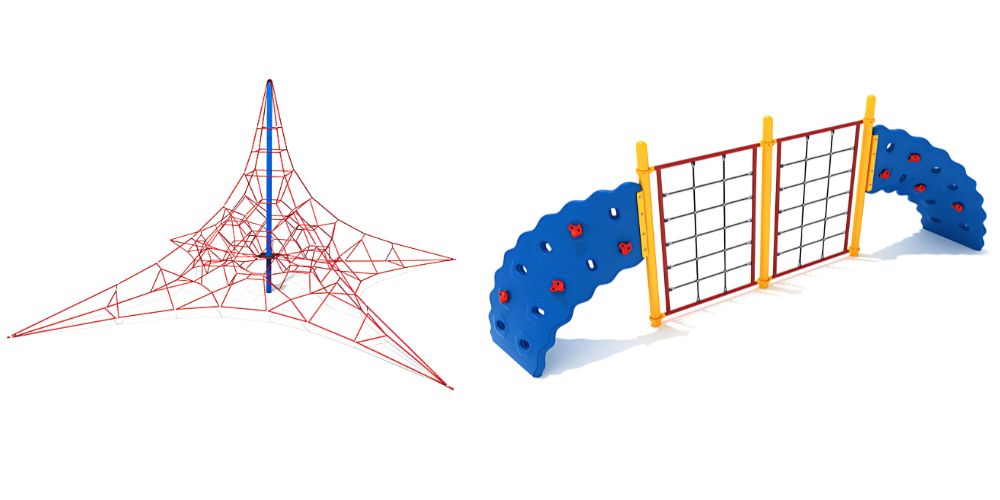
A Net Climber is a piece of playground equipment designed for children aged 5 to 12 years old. It offers a climbing challenge with sloped sides and a climbing net made of galvanized steel piping and coated chains. Net Climbers can also have other attractions such as climbing walls or slides installed.
Net Climbers on playgrounds are highly entertaining and beneficial for children’s development, providing challenges for adventurous children and fostering social skills, confidence, and physical strength.
2. Horizontal Ladders

The Horizontal Ladder is a playground climber that is a classic and beloved structure! It challenges children’s upper body strength and coordination as they traverse the overhead ladder. Horizontal Ladders can feature the traditional rungs or the gripping area may be shaped differently. Free-standing horizontal ladders can exist separately, yet integrated horizontal ladders form part of bigger structures, including ring and rope bridge components.
3. Rock Walls
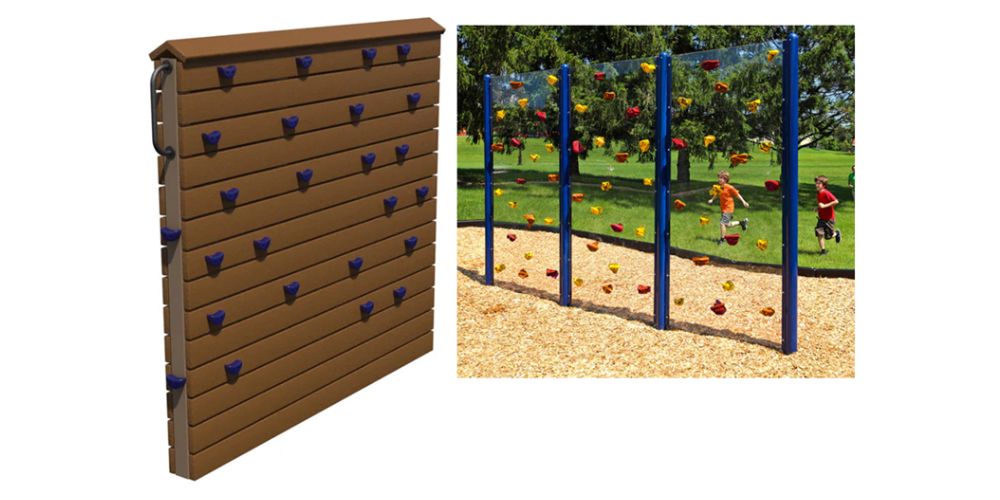
The climbing features, consisting of structure panels and simulated rock grip handles, enable children to master fundamental rock climbing skills, balancing techniques, and grip development while learning about risk evaluation.
Children can safely scale and descend the climbing surface through its molded grip system, like a rock wall.
4. Geodesic Domes
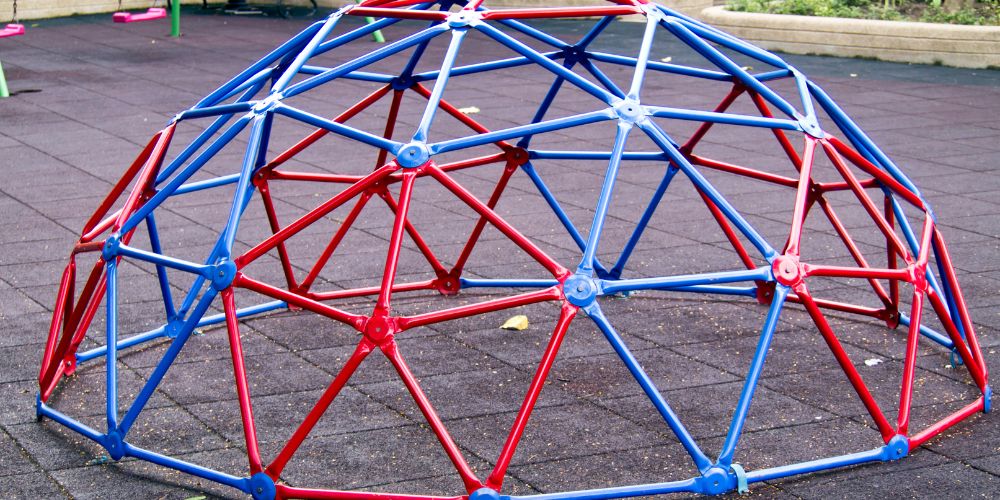
Geodesic domes are spherical climbing structures constructed from metal rods. They allow children to climb through them.
Metal interlocking bar structures form domes that enable creative climbing behavior while promoting social bonding among young clients. The equipment’s open construction allows children to move in an unrestricted direction.
Motion-Based Equipment Names & Terms
1. Spring Riders

The spring rider is an outdoor playground vehicle with a mounted spring that allows children to experience forward and backward rocking motion.
Spring riders take the forms of animals, vehicles, and creative animals while resting upon a strong foundation that supports a sturdy spring. Rocking back and forth enables children to picture themselves in racing scenes, flight sequences, or traveling to new territories, making spring riders important for imaginative activities.
2. Spinners

Playing on spinners introduces fresh variations of rotational activities. Modern carousel alternatives include various platforms, such as those you stand on and those designed for inclusive ground play. Spring riders serve two functions: they teach children to balance and help them understand sensory interactions through exciting play activities.
The spinner works as a rotating piece of equipment that functions by itself or with support from other mechanisms.
Sensory and Imaginative Play
1. Sensory Panels
Sensory panels are interactive touch, sight, and sound-experiencing surfaces for children.
Sensory panels activate child development through touch features, multifunctional illumination and sound devices, and interactive interface elements. They support children with sensory processing difficulties because they provide subdued interactive activities.
2. Tunnels and Crawl Spaces
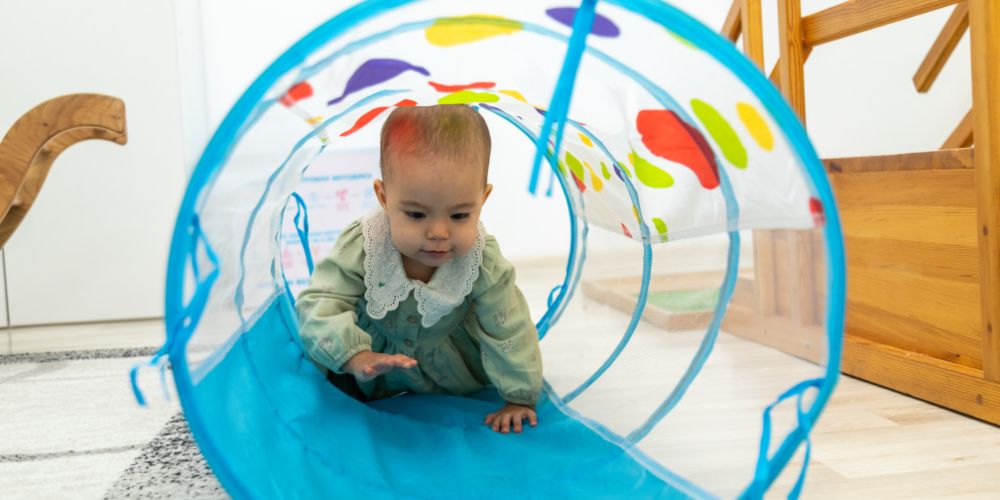
The enclosed passage of a tunnel provides children a space for exploration and coordination development while they crawl through it.
Kids benefit from these small enclosed spaces because they stimulate their creativity and help develop their large motor functions. These structures appear as logs or tubes and offer various texture options, aesthetics, and the option to place them underground for greater thrills.
3. Musical Play Equipment

Interactive instruments called musical play equipment permit children to generate sounds while creating musical rhythms.
Children develop auditory skills, and their creativity flourishes when they play musical instruments outside, ranging from xylophones to chimes and drums. The playground equipment provides sensory-rich, inclusive activities that welcome every child to participate in non-competitive activities.
Playground Amenities
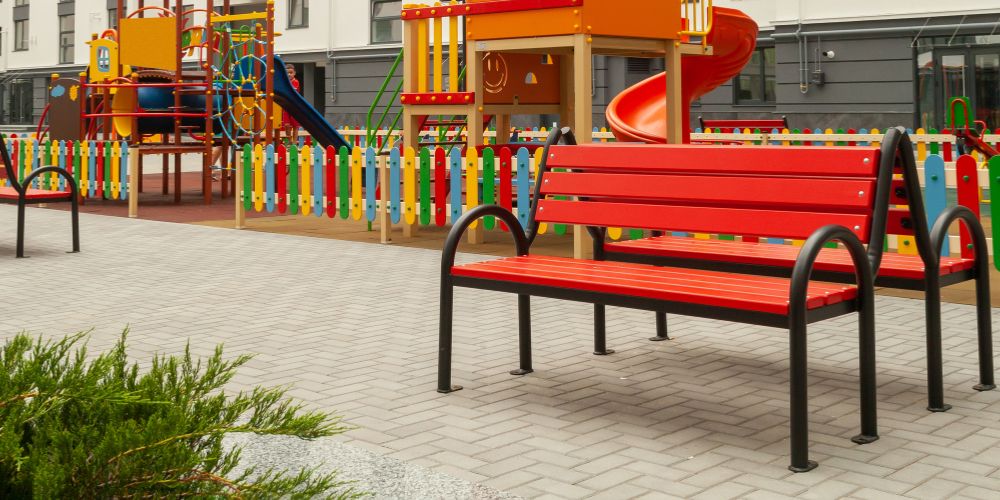
Playground amenities are helpful additions that enhance comfort and usability during visits.
The facilities exist to improve accessibility instead of being solely intended for active playing opportunities. The playground includes seating areas, shaded spaces with waste containers, dining tables, and bike racks. These elements provide useful benefits to the caregivers and turn playground surroundings into areas for community engagement.
Safety Terms and Standards
Safety terms, which function as preventive regulations and operational standards, depend on protecting users and establishing healthy playground usage.
The selection or design process of playgrounds requires a basic comprehension of safety terms such as “fall zone,” as well as understanding “use zone” and identifying “entrapment.” The safety standards for equipment originate from ASTM, CPSC, and IPEMA, as they specify required safety requirements.
Essential Acronyms
- ADA (Americans with Disabilities Act): Ensures playground accessibility for children of all abilities.
- ASTM: Develops standards for playground safety and material quality.
- CPSC: Oversees consumer safety, including playground regulations.
- IPEMA: Certifies play equipment and surfaces for safety compliance.
Conclusion: Partner With Playground Equipment USA for Expert Solutions
Learning playground equipment vocabulary helps in more ways than just appearing intelligent. Understanding the vocabulary and ideas help develop spaces that welcome everyone safely, that also provide enjoyment to users. Selecting the proper playground apparatus will establish better play opportunities for every child.
Playground Equipment USA provides premium playground equipment with knowledgeable team members to help users turn their developmental space concepts into reality. Our team provides turnkey assistance to our customers through all stages of playground development to establish exciting installations that are adored by communities and children equally.
